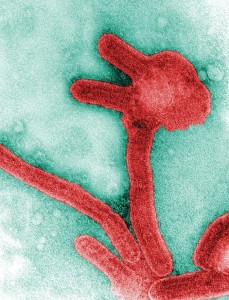In a paper published ahead of print in the Proceedings of the National Academy of Sciences, researchers from the University of Leeds and the University of York have discovered a unique code in single stranded RNA viruses that dictate the packaging instructions of a fully formed virus, providing a potential drug therapy target.

Single stranded RNA (ssRNA) viruses are an incredibly diverse viral group capable of infecting plants and animals. Common ssRNA viruses causing human disease are picornaviridae (rhinovirus [the common cold], polio), coronoaviridae (SARS, MERS), and filoviridae (Ebola, Marburg). Positive ssRNA viruses have their genetic material directly translated into usable proteins, while negative ssRNA viruses use an RNA replicase enzyme to convert their genetic material to positive strands before being used to make proteins. As evidenced by the efficacy of the seasonal flu vaccine and the ongoing trials for an Ebola cure, pharmacological interventions to cure a ssRNA infection are few and far between.
Now, years after original research was published on ssRNA packaging within a cell, the English researchers have shown that viral RNA induces conformational changes in capsid proteins, essentially telling the viral packaging it is ready to bud from the infected cell. Previous research from this group showed that particular viral genomes only induce their own cognate capsid to undergo conformational changes, indicating a genome- and virus-specific directionality. Mathematical models derived from further collaborations demonstrated ssRNA virus capsids are able to avoid host immune responses by folding themselves in one of only a small number of ways, inducing host defense responses only when the viral genome produces the conformational change; by then, the virus is budding from the cell and is no longer affected by internal defense mechanisms.
This latest study took the predicted protein structures from the mathematical models and showed, through single-molecule microscopy, that conformational changes only occur when viral genomes interact with their respective capsids using simple, identifiable genomic motifs. The researchers dubbed this motif/capsid conformational system the ‘Enigma machine’. There are profound implications for future ssRNA virus research: “[This] is like finding a secret message within an ordinary news report and then being able to crack the whole coding system behind it,” said Dr Roman Tuma, Reader in Biophysics at the University of Leeds. “[The paper] also demonstrates that we could design molecules to interfere with the code, making it uninterpretable and effectively stopping the virus in its tracks.” That is good news for the 1 billion rhinovirus infections occurring each year, not to mention other rarer but more deadly infections.

